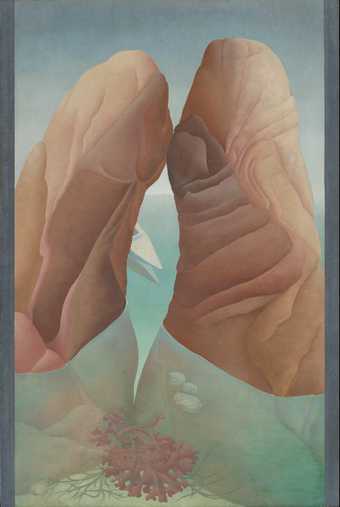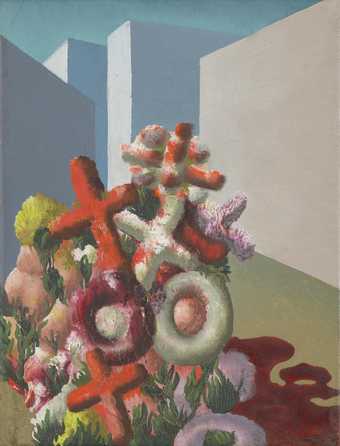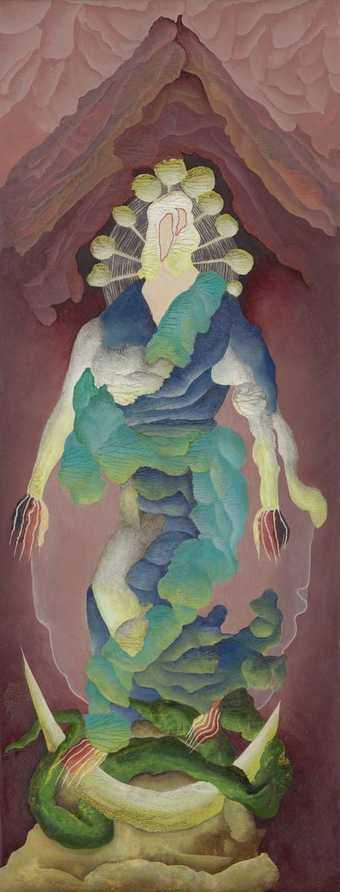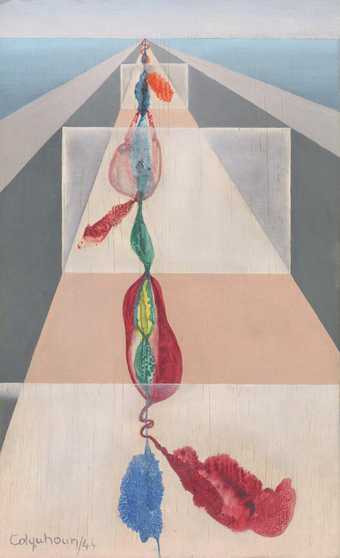
Not on display
- Artist
- Ithell Colquhoun 1906–1988
- Medium
- Oil paint on canvas
- Dimensions
- Support: 921 × 612 mm
frame: 1053 × 749 × 40 mm - Collection
- Tate
- Acquisition
- Presented by the National Trust 2019
- Reference
- T15310
Summary
Landscape with Antiquities (Lamorna) is an oil painting on canvas which depicts an aerial view of a landscape containing diverse archaeological and natural features. A road which forks at the upper and lower edges of the painting divides the composition into sections, each containing different archaeological structures. At the lower edge, a cone-shaped object is silhouetted against a brown background, while a green section on the left contains a stone circle and a sun-wheel cross. In the red and dark-blue section to the right, the features include overlapping square and rectangular buildings, standing stones and a Greek cross mounted on a plinth. A mysterious red tongue-shaped object occupies the centre of the painting. The work has been dated 1955 by a previous cataloguer and the title and this date are inscribed on the verso; however, a work titled Landscape with Antiquities (Lamorna) was exhibited at the Women’s International Art Club Jubilee Exhibition in 1950 (no.383) which suggests that the date may be 1950 or earlier.
The landscape is an imagined representation of the Lamorna Valley on the Penwith Peninsula in the far west of Cornwall, a place renowned for its concentration of prehistoric sites. Colquhoun described this picture as ‘a map-like painting which features the Merry Maidens, Vow Cave, a holed stone and some Celtic crosses to be found in the Lamorna area’ (in Cornish Banner, June 1978, quoted in Shillitoe 2009, p.313). Local antiquities depicted include the stone circle known as the Merry Maidens with Nun Careg cross below it, and the holed stone that is sited across the road from the circle. To the right of the bend in the road are The Pipers, two standing stones on a hill. At the top of the image to the left of the fork in the road is Boskenna Cross, with Gun Rith standing stone to its right; above are other wayside crosses on the St Buryan road. At the bottom of the image rectangular buildings represent Vow Cave Studio with the Lamorna River flowing either side of it, and below the fork in the road is Vow Cave (a rock above the Lamorna Valley after which Colqhoun named her studio). Although these objects are placed in their rough geographical relationship to one another and some can be identified on an ordnance survey map, more important is their personal significance to Colqhoun in representing the layers of history and perceived mysticism in the landscape around her studio in Cornwall.
In the 1950s Colquhoun was working on the manuscript of her book The Living Stones (published 1957) which explored the relationship between the landscape and the traces of human occupation throughout history including ancient sacred structures from Neolithic monuments to medieval crosses. She wrote:
In a profound sense the structure of its rocks gives rise to the psychic life of the land: granite, serpentine, slate, sandstone, limestone, chalk and the rest have each their special personality dependent on the age in which they were laid down, each being co-existent with a special phase of the earth-spirit’s manifestation … Not only the Tors, but also the ‘rude stone monuments’, the more widely acknowledged relics of an unimagined age, are repositories still of ancient power, are the living stones … Old stone crosses, too are full of psychic life.
(Colqhoun 1957, pp.46–8.)
Colquhoun’s personal encounters with these monuments took place on her walks around Lamorna. In The Living Stones she describes a walk along the road from St Buryan to her studio:
It seemed that my way home was marked out by ancient stones; the area around St Buryan church was one of the four Sanctuaries of Cornwall and some of the many crosses still mark its boundaries, though others have been displaced … The carving of the one at the crossroads is much worn; the other in the churchyard is more elaborately sculptured and better preserved. Both stand on large plinths or almost pyramids of granite, weeds and grasses taking hold in the chinks; and both are of the ‘sun-wheel’ type. Another, by the wayside beyond the village is in the form of a Greek cross; further on you pass the one at the St. Loy turning, and lastly, a humble wheel-cross hides in the grass beyond the circle of Nun-Cerag, between the holed stone and the famous ‘Pipers’. Here was a mingling without discrepancy, as once in the now-shattered ambience of Glastonbury and still (I have heard) in Iona, of Pagan and Christian numina; a genuine synthesis has been achieved.
(Colquhoun 1957, p.194.)
This passage traces in text the journey that is laid out visually in the painted map in this picture, but also shows how Colquhoun understood the layering of ancient sacred structures to represent the residue of different psychic histories in the Cornish landscape. Landscape with Antiquities (Lamorna) is thus both the representation of a personal journey and a map of the mystic forces in the Lamorna Valley.
Further reading
Women’s International Art Club, Jubilee Exhibition: 50 Years of Women Painters and Sculptors including Special Italian Section, Royal Society of British Artists Galleries London, 6–24 March 1950, p.11, no.383.
Ithell Colqhoun, The Living Stones, London 1957.
Eric Ratcliffe, Ithell Colquhoun: Pioneer Surrealist Artist, Occultist, Writer and Poet, Oxford 2007, p.156, reproduced.
Richard Shillitoe, Ithell Colquhoun: Magician Born of Nature, lulu.com, Morrisville, North Carolina 2009, no.499, p.313 (dated 1950).
Emma Chambers
October 2018
Does this text contain inaccurate information or language that you feel we should improve or change? We would like to hear from you.
You might like
-
Ithell Colquhoun Scylla
1938 -
Ithell Colquhoun E.L.A.S.
1945 -
Ithell Colquhoun Attributes of the Moon
1947 -
Ithell Colquhoun Ages of Man
1944




